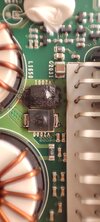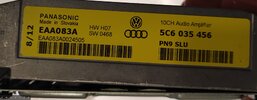peepermeeper
New Member
Hello,
I need help identifying these components Any help would be appreciated. I have an r12 amplifier for a vw passat 2012 fender sound system attached is a picture of all the serial numbers the pair of black boxes with a line that goes down it and is inscribed sc 1a and has a symbol perhaps a switched capacitor? Maybe sg 1a?
Thanks,
Peep
I need help identifying these components Any help would be appreciated. I have an r12 amplifier for a vw passat 2012 fender sound system attached is a picture of all the serial numbers the pair of black boxes with a line that goes down it and is inscribed sc 1a and has a symbol perhaps a switched capacitor? Maybe sg 1a?
Thanks,
Peep
Attachments
Last edited:








